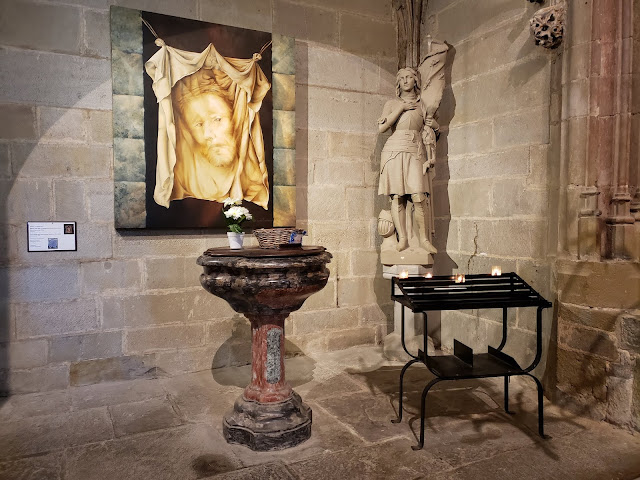Sally and Beth host inSPIREd Sunday!
May 2019 - Carcassonne France
May Carcassonne Evening
May Carcassonne Citadel tour
The Basilica of Saints Nazarius and Celsus is a Roman Catholic minor basilica located in the citadel of Carcassonne, France. It is a national monument, and is in the Gothic-Romanesque architectural tradition.
Saints Nazarius and Celsus were two martyrs of whom nothing is known except the discovery of their bodies by Saint Ambrose.
According to Paulinus the Deacon's Vita Ambrosii, Ambrose, at some time within the last three years of his life, after the death of the Emperor Theodosius (d. 395), discovered in a garden outside the walls of Milan the body of Saint Nazarius, with severed head. Nazarius's blood was reportedly still liquid and red when his body was exhumed by Ambrose. Ambrose had it carried to the Basilica of the Apostles. In the same garden Ambrose likewise discovered the body of Saint Celsus, which he had transported to the same place. The Catholic Encyclopedia states: "Obviously a tradition regarding these martyrs was extant in the Christian community of Milan which led to the finding of the two bodies."
On 12 June 1096, Pope Urban II visited the town and blessed the building materials for the construction of the cathedral. Construction was completed in the first half of the twelfth century. It was built on the site of a Carolingian cathedral, of which no traces remain. The crypt too, despite its ancient appearance, dates from the new construction.
Around the end of the 13th century, during the rule of kings Philip III, Philip IV, and the episcopates of Pierre de Rochefort and Pierre Rodier, the cathedral was reconstructed in the Gothic style. It remained the cathedral of Carcassonne until 1803, when it lost the title to the present Carcassonne Cathedral (Cathédrale Saint-Michel de Carcassonne)
The central stained glass window of the choir from 1280 is one of the oldest ones in the south of France. Together with the upper trefoils (the Resurrection of Jesus and the Resurrection of the dead), it depicts the life of Jesus in 16 medallions.
Joan of Arc in the corner.
Now I'm intrigued by these saints' names!
Saints Nazarius and Celsus were two martyrs of whom nothing is known except the discovery of their bodies by Saint Ambrose.
According to Paulinus the Deacon's Vita Ambrosii, Ambrose, at some time within the last three years of his life, after the death of the Emperor Theodosius (d. 395), discovered in a garden outside the walls of Milan the body of Saint Nazarius, with severed head. Nazarius's blood was reportedly still liquid and red when his body was exhumed by Ambrose. Ambrose had it carried to the Basilica of the Apostles. In the same garden Ambrose likewise discovered the body of Saint Celsus, which he had transported to the same place. The Catholic Encyclopedia states: "Obviously a tradition regarding these martyrs was extant in the Christian community of Milan which led to the finding of the two bodies."
On 12 June 1096, Pope Urban II visited the town and blessed the building materials for the construction of the cathedral. Construction was completed in the first half of the twelfth century. It was built on the site of a Carolingian cathedral, of which no traces remain. The crypt too, despite its ancient appearance, dates from the new construction.
Around the end of the 13th century, during the rule of kings Philip III, Philip IV, and the episcopates of Pierre de Rochefort and Pierre Rodier, the cathedral was reconstructed in the Gothic style. It remained the cathedral of Carcassonne until 1803, when it lost the title to the present Carcassonne Cathedral (Cathédrale Saint-Michel de Carcassonne)
The central stained glass window of the choir from 1280 is one of the oldest ones in the south of France. Together with the upper trefoils (the Resurrection of Jesus and the Resurrection of the dead), it depicts the life of Jesus in 16 medallions.
Joan of Arc in the corner.











...dramatic to say the least!
ReplyDeleteBeautiful church
ReplyDeleteThat is incredible!
ReplyDeleteInteresting post. The final photo is very striking.
ReplyDelete